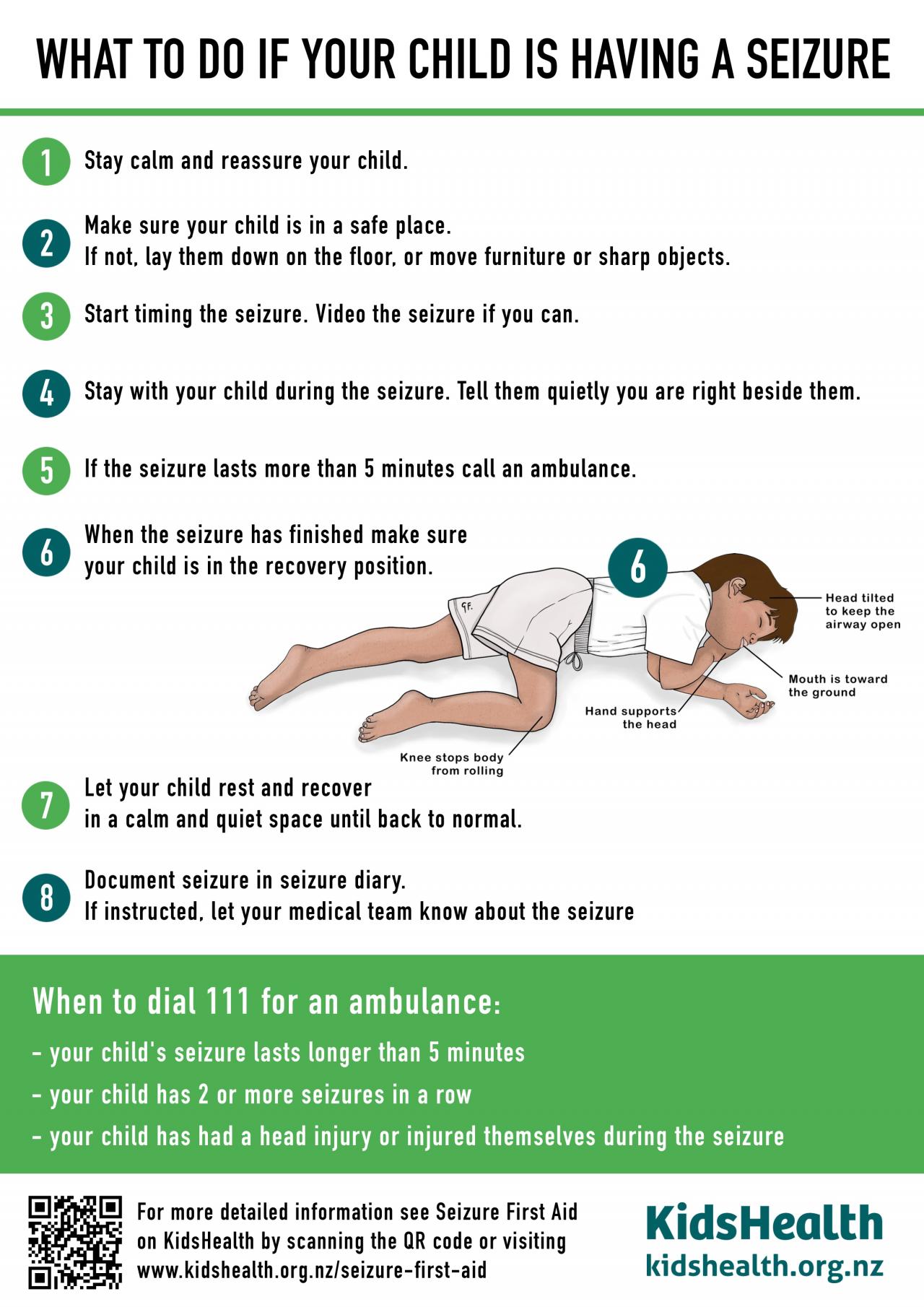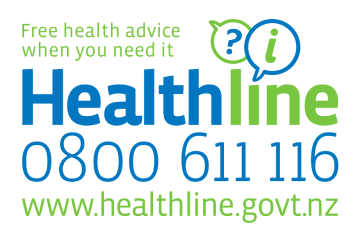Febrile Seizures
Febrile Seizures
Febrile seizures are a common childhood problem. They happen in tamariki (children) between the ages of 6 months and 6 years.
Key points about febrile seizures
Febrile seizures are a common childhood problem.
- febrile seizures are a common childhood problem
- they are triggered by a fever that is usually caused by a viral infection
- they can look scary, but they hardly ever cause long-term problems
- the most important thing is to try to keep calm, and keep your child safe - after the seizure, lie your child down on their side, in the recovery position
- dial 111 within New Zealand (use the appropriate emergency number in other countries) and ask for urgent medical help if the seizure lasts more than 5 minutes, or if your child has trouble breathing, or you are worried
- when your child is having a seizure, do not put anything in their mouth and do not put them into a bath or shower to cool down
- take your child to a health professional afterwards to find out why they have a fever
What is a febrile seizure?
Febrile seizures happen in tamariki between the ages of 6 months and 6 years.
The word febrile means 'with fever'. A febrile seizure is an epileptic seizure that happens when a child has a seizure triggered by a fever. But, febrile seizures are not the same as epilepsy.
People have sometimes called febrile seizures 'fever fits' or 'febrile convulsions'.
What puts my child at risk of having a febrile seizure?
Febrile seizures are common - about 1 in 20 tamariki have them. Febrile seizures happen between the ages of 6 months and 6 years. There is a higher chance of your child having a febrile seizure if a close relative had febrile seizures as a child.
What causes febrile seizures?
Many infections in tamariki cause fevers. Some tamariki are born with genes that make them more likely to have seizures when they have a fever. The fever does not cause the seizure but can trigger one in these tamariki.
Tamariki with febrile seizures do not have a seizure with every fever. In fact, most tamariki will only ever have 1 febrile seizure in their lifetime.
Usually, the fever is caused by a viral infection, such as a cold. Sometimes, the fever is caused by a bacterial infection, such as pneumonia, a urine infection, an ear infection or occasionally, meningitis. Bacterial infections can be serious. Take your child to a health professional after the febrile seizure to find out why they have a fever.
What happens during a febrile seizure?
Most febrile seizures stop by themselves.
When your child has the seizure, they will become unresponsive. They may become stiff or their arms and legs may start to twitch or jerk. Their eyes may roll back. Often they are floppy afterwards.
The seizure can seem to go on for a long time but they usually only last a minute or two and will stop by themselves.
After the jerking or stiffness stops, your child will usually sleep for a while (up to an hour). Some tamariki appear to be very upset and then become sleepy.
Watching your child have a febrile seizure can be very frightening, especially if it is the first time. Many parents think their child is dying during the seizure. Tamariki do not die during febrile seizures.
What do I do if my child has a febrile seizure?
Most febrile seizures stop by themselves.
How do I keep my child safe?
The most important thing to do is to keep your child safe while they are having a seizure.
- lie your child down on their side
- do not put anything in their mouth (they will not swallow their tongue)
- do not put your child in the bath or shower to cool them down
- loosen their clothes around their face and neck
- wait a few minutes for the seizure to stop - check the time if you can to see how long the seizure lasts
When should I see a doctor?
You should take your child to see a doctor after the seizure finishes. The doctor will check to see what is causing the fever.
When should I see a doctor urgently?
Most tamariki are sleepy after a seizure, but if they are hard to wake, or if you are worried about them for other reasons, see a doctor urgently.
When should I dial 111?
Dial 111 within New Zealand (use the appropriate emergency number in other countries) and ask for urgent medical help if:
- the seizure lasts longer than 5 minutes
- your child is having trouble breathing
- your child looks very unwell
- your child is not waking up and responding after the seizure
Will a febrile seizure harm my child?
A febrile seizure in a healthy child very rarely causes long-term harm. Febrile seizures that last less than an hour do not cause brain damage or death.
If my child has had one febrile seizure will they have another?
Between 10% and 15% of tamariki have more than 1 seizure in the same illness. Once the seizure has finished, take your child to a doctor again.
If your child starts a second seizure before waking from the first one, you should dial 111 within New Zealand (use the appropriate emergency number in other countries) for urgent medical help.
About 1 in 3 tamariki who have had 1 febrile seizure will have another one with another fever. This is more likely to happen if there are other people in your whānau (family) who have had febrile seizures. The risk decreases as your child gets older.
By the age of 6 years, tamariki have usually grown out of febrile seizures.
Will my child develop epilepsy after a febrile seizure?
Febrile seizures are not a form of epilepsy and do not cause epilepsy. The risk of any child developing epilepsy is 1 in 200. The risk is slightly higher (1 in 100) for tamariki who have had a febrile seizure.
The chance of a child developing epilepsy is higher again (less than 15 in 100) if:
- a child has developmental delay
- the febrile seizure lasted longer than 15 minutes or involved one side of the body or there was more than one seizure in the first illness
- there are other people in the whānau who have epilepsy
How are febrile seizures treated?
Most febrile seizures stop by themselves in 1 or 2 minutes. They do not need any treatment.
If the seizure lasts longer than 5 minutes, dial 111 within New Zealand (use the appropriate emergency number in other countries) and ask for urgent medical help.
If your child had a febrile seizure that lasted more than 5 minutes, your doctor will give you some medicine to use in case a future seizure lasts longer than 5 minutes.
See the KidsHealth page on emergency epileptic seizure medicine to learn more
Does my child need to stay in hospital after a febrile seizure?
If your child recovers completely from the febrile seizure, and they do not have a serious infection, they do not need to stay in hospital.
How can I prevent my child having a febrile seizure?
There is no way to prevent febrile seizures.
Keeping your child cool when they have a fever will make them feel more comfortable but will not prevent a febrile seizure. The best ways to bring your child's temperature down are by:
- undressing your child so that they are just wearing a single layer (for example, a singlet and pants)
- making sure the room is not too hot or too cold
If your child is miserable because of the fever, you can give paracetamol to make them more comfortable. You must follow the dosage instructions on the bottle. It is dangerous to give more than the recommended dose. Giving regular paracetamol or ibuprofen will not prevent a febrile seizure.
Printable emergency seizure plan
This emergency seizure plan is a step-by-step guide for what to do if your child is having a seizure. You can print it out and keep a copy on the fridge or somewhere that everyone can see it.
See the KidsHealth page for a printable version of a seizure first aid plan
This page last reviewed 06 June 2024.
Do you have any feedback for KidsHealth?
If you have any feedback about the KidsHealth website, or have a suggestion for new content, please get in touch with us.
Email us now
